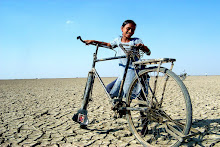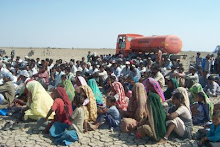Economic Times: Gandhinagar:
Tuesday, 29 September 2020.
As October lurks around the corner, Bharat Somera is worried. By now, he should have been in the Rann, setting up his pan to produce salts. But so far with the incessant monsoon, his workplace is under several feet of water.
Somera is not alone. Thousands of salt pan workers of Gujarat, who spent eight months in a
year in the open Rann of Kutch producing salt are in a x. If the lockdown ate into their half of
previous season, extended monsoon is now biting into their current one.
Salt pan workers or Agariyas as they are commonly known in Gujarat migrate to Little Rann of Kutch with their families to set up their pans by September at the end of monsoon and continue working till May or even June depending on the arrival of monsoon, when the Rann gets totally submerged under water. The process of setting up the pan takes some time and typically process of production starts after mid-October.
“We can’t go now though we should have,” Somera told ET from Patadi block in Surendranagar District. “Obviously a delayed start will reduce production and we have to bear
another hit yet again,” he adds. “Also, the government occasionally releases water in the Rann, which ruins the salt pans and with excessive rains, that is a fear that we shall always have,” he added.
Gujarat for the records produces almost 74 percent of India’s total salt production of 25 million tonnes. “The production cycle was delayed even last year due to prolonged rain and the first crop of salt had come in around mid-December,” says Bharat Raval, President of Indian Salt Manufacturers Association. Speaking to ET from Jamnagar Raval pointed out that while lockdown due to COVID19 had little direct effect among the salt pan workers, who were working in the remote Rann areas, the production and distribution took a hit which in turn effected the Agariyas.
“Salt production is a seasonal and heavily weather dependent activity which majorly depends on rains,” Raval pointed out adding that while the industry had only about four months of productivity in the last season due to a delayed start, lockdown and timely arrival of monsoon
this year, it is all set to lose couple of more months this year due to rains.
“We are looking at a 30 per cent reduced, production this year as well,” Raval told ET.
“Between 2019-20 and 2020-21 we are losing out almost an entire season and that way even to break even the expenditures will be difficult for the Agariyas,” he added.
As October lurks around the corner, Bharat Somera is worried. By now, he should have been in the Rann, setting up his pan to produce salts. But so far with the incessant monsoon, his workplace is under several feet of water.
Somera is not alone. Thousands of salt pan workers of Gujarat, who spent eight months in a
year in the open Rann of Kutch producing salt are in a x. If the lockdown ate into their half of
previous season, extended monsoon is now biting into their current one.
Salt pan workers or Agariyas as they are commonly known in Gujarat migrate to Little Rann of Kutch with their families to set up their pans by September at the end of monsoon and continue working till May or even June depending on the arrival of monsoon, when the Rann gets totally submerged under water. The process of setting up the pan takes some time and typically process of production starts after mid-October.
“We can’t go now though we should have,” Somera told ET from Patadi block in Surendranagar District. “Obviously a delayed start will reduce production and we have to bear
another hit yet again,” he adds. “Also, the government occasionally releases water in the Rann, which ruins the salt pans and with excessive rains, that is a fear that we shall always have,” he added.
Gujarat for the records produces almost 74 percent of India’s total salt production of 25 million tonnes. “The production cycle was delayed even last year due to prolonged rain and the first crop of salt had come in around mid-December,” says Bharat Raval, President of Indian Salt Manufacturers Association. Speaking to ET from Jamnagar Raval pointed out that while lockdown due to COVID19 had little direct effect among the salt pan workers, who were working in the remote Rann areas, the production and distribution took a hit which in turn effected the Agariyas.
“Salt production is a seasonal and heavily weather dependent activity which majorly depends on rains,” Raval pointed out adding that while the industry had only about four months of productivity in the last season due to a delayed start, lockdown and timely arrival of monsoon
this year, it is all set to lose couple of more months this year due to rains.
“We are looking at a 30 per cent reduced, production this year as well,” Raval told ET.
“Between 2019-20 and 2020-21 we are losing out almost an entire season and that way even to break even the expenditures will be difficult for the Agariyas,” he added.
“Agarias
were hit primarily because the lockdown chocked up the supply lines for a period
and then the halting of exports which would lead to lesser price,” said
Ghanshyam Zula an activist from Santalpur in Patan District. “Now again losing
a month will prove costly for the community,” he added.
“Across the state almost 18,000 families are involved in salt pans across Rann and coastal areas,” said Pankti Jog from Agariya Hit Rakshak Manch (AHRM) in Ahmedabad. “We are talking about 50000 people here,” she added. “For these people, there is not much of an option for their livelihood on one hand and secondly a fall in Salt production will have major impact in other industries,” she added.
Raval however pointed out that while India’s production of Salt has gone up from 15.6 million tonnes in 2000 to the range of 35-38 million tonnes by 2020 as of now the reduced production will not have significant impact on domestic market. However, the impact will largely be borne by the industry and the Agariyas, who are looking at a much-reduced yield for yet another season of hard work in the Sun, he added.
“Across the state almost 18,000 families are involved in salt pans across Rann and coastal areas,” said Pankti Jog from Agariya Hit Rakshak Manch (AHRM) in Ahmedabad. “We are talking about 50000 people here,” she added. “For these people, there is not much of an option for their livelihood on one hand and secondly a fall in Salt production will have major impact in other industries,” she added.
Raval however pointed out that while India’s production of Salt has gone up from 15.6 million tonnes in 2000 to the range of 35-38 million tonnes by 2020 as of now the reduced production will not have significant impact on domestic market. However, the impact will largely be borne by the industry and the Agariyas, who are looking at a much-reduced yield for yet another season of hard work in the Sun, he added.
















.jpg)
.jpg)
.jpg)
.jpg)













No comments:
Post a Comment